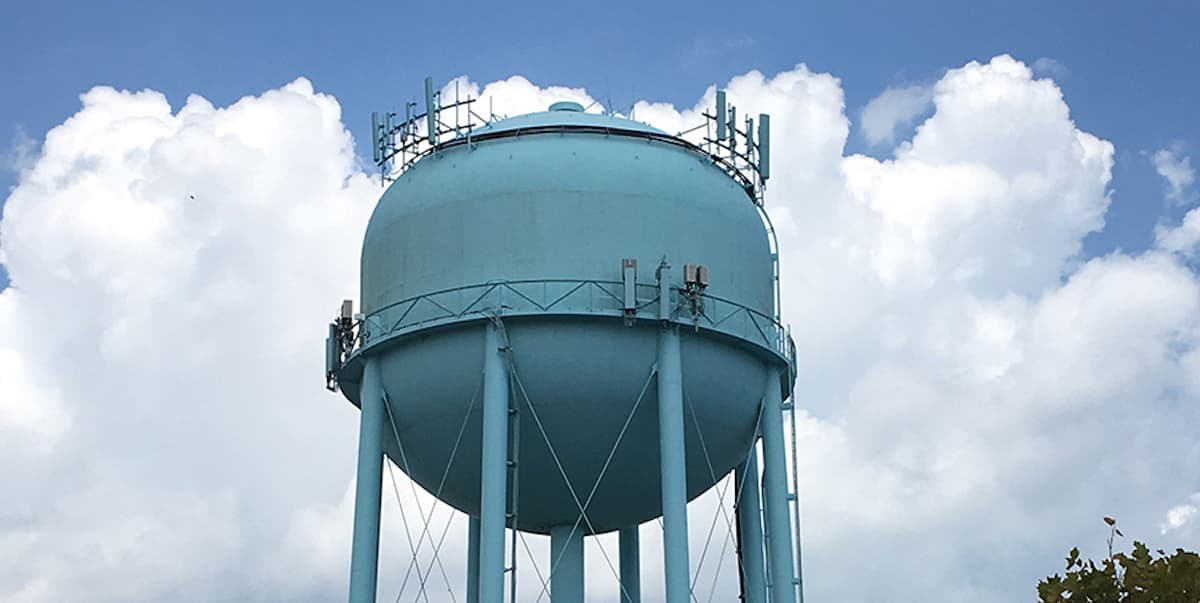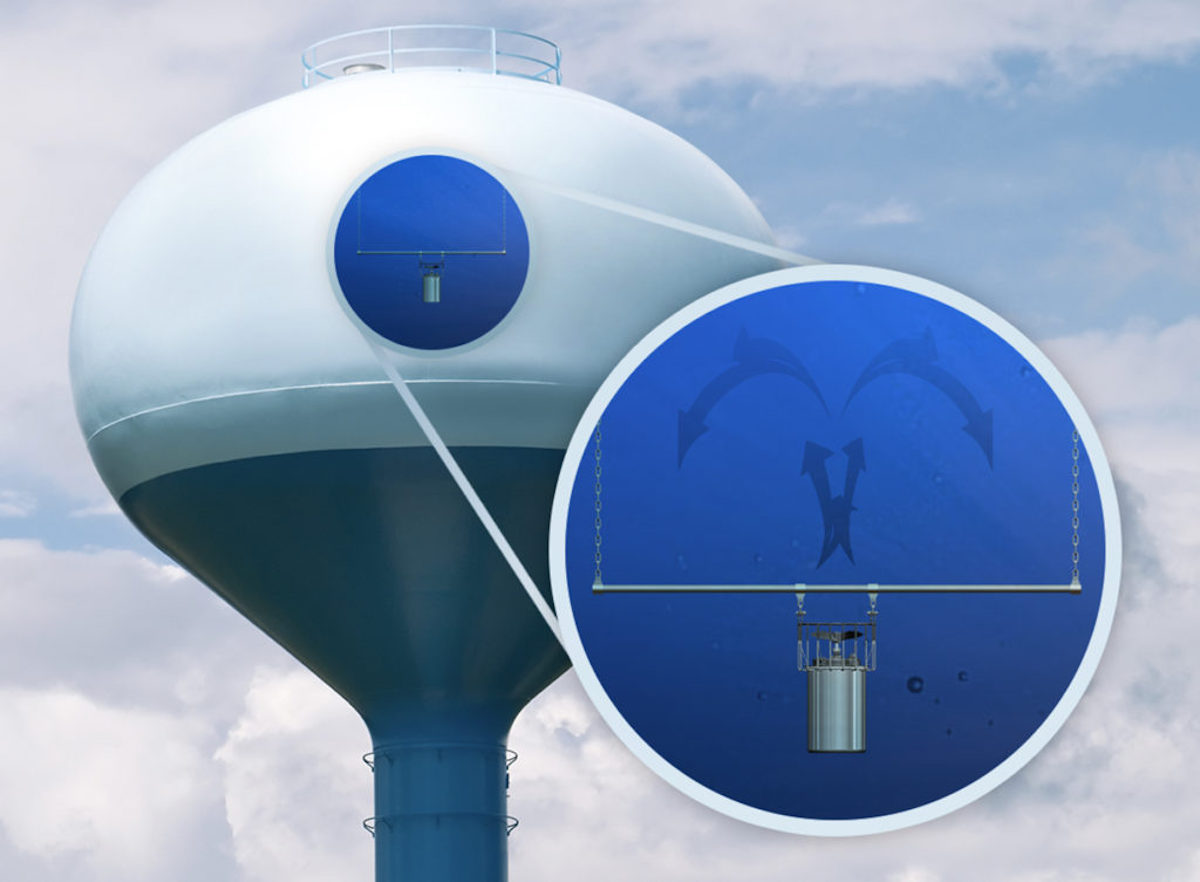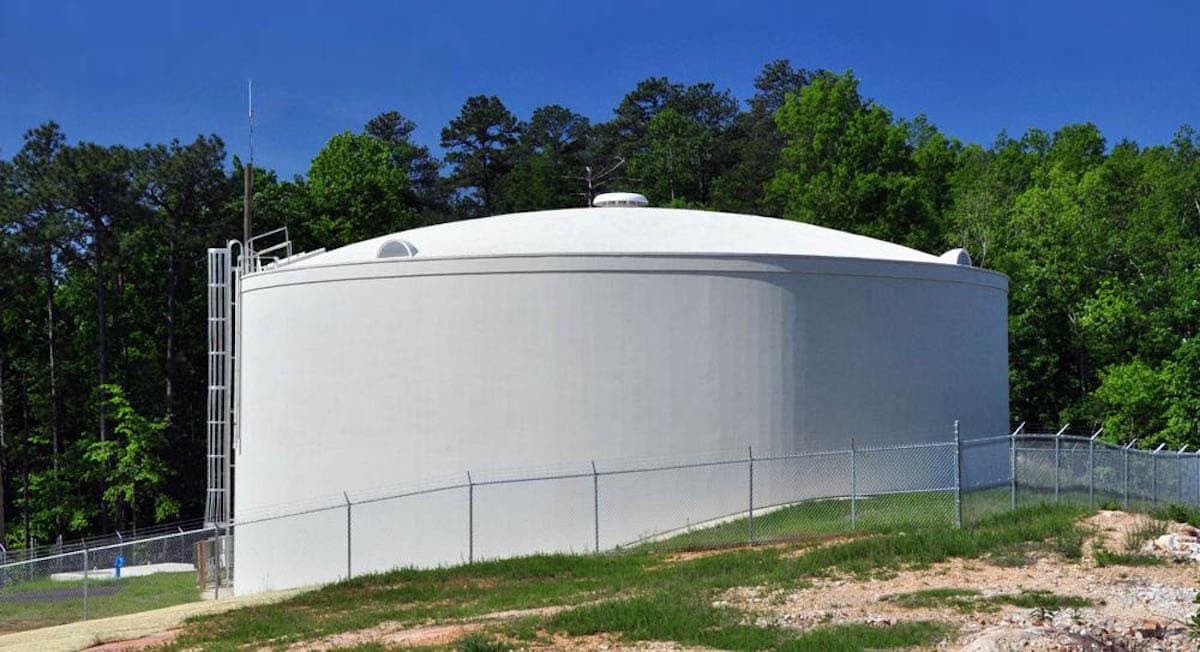Written by Thom Tackman, Kasco Marine Certified Water Operator (aka the guy with the hat!)
As a water treatment plant operator, with experience operating in Arizona, Illinois, and most recently in Missouri, my responsibility was to efficiently operate the surface water treatment plant(s) and to make sure they met all regulatory requirements. Over the past 45 years, I’ve completed hours of routine water quality testing, verifying that the water leaving the plant met regulatory requirements. And I don’t ever remember a single positive coliform sample leaving the water treatment facility. Throughout my experience, I’ve tried countless ways to ensure my drinking water was of high quality. By far, the best, most efficient and effective way I’ve found is by using an active water storage tank mixer.
Finding Inconsistency in Stored Water Quality
In Arizona, my water quality team members completed routine sampling in our distribution system for chlorine and coliform bacteria. Occasionally, we would get a positive sample in the distribution system with a measurable free chlorine residual. Immediately, we would resample again, and most of the time, the check sample would indicate no coliform bacteria. And we would also hold weekly water taste tests and normally the water tasted okay, but then there were times when the water tasted earthly or musty. Occasionally, we would even smell chlorine and hydrogen sulfide (i.e. a rotten egg odor).
Water quality and customer complaints are important. All city councils I worked with took both very seriously. It was a top priority for us to ensure that the water exiting the surface water treatment and our groundwater wells were good quality. So, we elected to look closer at our distribution and water storage tanks to see if we could improve the consistency in our water quality at the customer tap.

Difficulties in Testing for Consistency
TANK DESIGN
Our first discovery was that water storage tanks are not designed for sampling. In order to sample the water storage tanks, we had to first train our team on how to safely climb a water tank. Once we learned how to properly climb a tank, we had to find a way to sample the tank. Where possible, we installed tubing and siphoned water from the tanks to obtain a representative sample. Where we could not install a siphon, we used small sump pumps and pumped water, sampling from various levels inside the tank. In Arizona, we always tried to do the sampling as early as possible in the day because the tank tops would heat up by midday where it was almost impossible to work safely.
CHEMICAL STRATIFICATION
We found inconsistency in the stored water quality. We noticed that the chlorine levels would be good at the bottom of the tanks but would decrease to undetectable levels towards the top of the tank. In order to increase the chlorine residual, we would add chlorine. First with chlorine tablets and then later with bleach.
We calculated the volume of the tank(s) then added the amount of chlorine to reach the desired residual. We would retest, hoping that the chlorine residual would reach the desired level. It never occurred to us that the chlorine compounds simply could not disperse within the tank without additional mixing action to break up the stratified water. We thought that the water flow into the tank would provide sufficient mixing action.
MANUALLY MIXING
During my time in Arizona, we didn’t have active tank mixers installed—and trying to manually mix a 0.5 MG or larger tank through a tank hatch just was not feasible. We attempted to modify the inlet and outlet of the storage tanks so that the water would come into the top of the tank and exit through the bottom. It sounded like a good idea, but some of the tanks only filled for an hour or two per day, and poor water quality remained.
RECIRCULATION PUMPS
Lastly, we then added large external recirculation pumps to mix the storage tanks. That too came with limited success in improving water quality. In one 10.0 MG tank, we installed baffle walls at the recommendation of our consulting engineer and that increased the amount of surface area for biofilm to grow and made tank cleaning nearly impossible. To say the least, we tried many, many different options to fix the poor water quality of these tanks without much success.
In the end, my story shows an endless cycle of testing and trying new methods to fix the problems that regularly occur in water tanks nationally.
Thermal Stratification Explained
Growing up in the midwest we swam in lakes where the water was always warm on the surface and cold at our feet so it seemed normal for stored drinking water to be warm on the top and colder below.
We never thought about thermal stratification as a water quality problem until one day a diver was sent into a tank to clean it. He complained about the chlorine odor in the headspace and how hot the water was near the surface of the tank. As I recall, he called that phenomenon thermal stratification and said most all tanks have the same water temperature variation regardless if they’re above the ground or constructed in the ground.

Kasco’s CertiSafe™ Mixer operating in an elevated tank.
Thermal stratification is what occurs in a body of water where two distinct temperature layers develop. In the summer, the warm water or epilimnion layer is on top and cold water or hypolimnion layer is below. During the winter; however, ice forms on the surface, and the warmer water is located below the ice.
Thermal stratification is well known in the naval warfare arena. There is a barrier of water in our ocean that can screen out modern sonar equipment making it difficult for subsurface boats to detect ships on the surface and vice versa. The stratification in water storage tanks is also due to a variation in water temperature. The sun warms the tank exterior transmitting that heat to the water. Warmer water molecules are lighter and less dense so they remain on top of the cooler and denser water.
Studies have concluded that thermal stratification occurs in as little as four hours. And, a degree or less of temperature difference will create the barrier mentioned, separating the cooler water from the warmer water; therefore, creating an increase in water age and chlorine decay rate on the water in the upper portion of the storage tank.
Passive vs. Active Tank Mixing
Over the past few years, several tank mixers have become available on the market to help break up thermal stratification in water storage tanks and to improve water quality. There are two types of tank mixers available:
- Passive mixers only function when water is flowing into the tank, and these mixers require supplied water pressure to operate.
- Active mixers are designed to operate continuously for 24 hours a day and-7 days a week.
When comparing passive and active mixers, first look at your application and determine the fill cycle of your tank. The mixing cycle should be shorter in duration than the fill cycle. For example, if you have a 1.0 MG tank and add 0.1 MG of water every 4 hours, then the mixer should be sized to complete the contents of the tank in less than 4 hours.
In addition to comparing the purchase cost, look at the warranty, find out if the unit can be rebuilt and the cost to rebuild it, annual power costs to operate it, and design/ease of installation.
Check out the motor bearing life. Mixers designed for long life will be supplied with bearings with an L-10 rating of 200,000 hours which are built to last for at least 20 years. Finally, ask for and check out references. Ask the references about warranty claims and overall satisfaction with the unit purchase, installation, and most importantly, operation. Is the mixer working for those operators as intended?
Water Quality Management and The Kasco CertiSafe™ Tank Mixer
Kasco began building quality mixers in 1968 primarily for the marine industry to keep ice from forming around and damaging docks. Some of the mixers also were used primarily in the northern states in water storage tanks to keep ice from building up and damaging the water storage tank.
In 2016, Kasco, at the request and advice of water storage tank owners, obtained NSF 61/372 certification for their mixers and surface aerators. NSF ratings can be either NSF compliant or NSF certified. The Kasco CertiSafe™ Mixer is NSF 61 certified. Make sure that you are comparing NSF qualifications when selecting a mixer.
Kasco builds over 15,000 mixers annually for various applications. Many of the mixers in operation today are in the marine industry for de-icing and were installed over 15 to 20 years ago. These quality mixers are built in Prescott, Wisconsin, and built to last. The secret to more than 50 years of success is that Kasco takes great pride in their products. We strive to provide the best mixers available that are held to the highest quality standards, are rebuildable, and backed by a great warranty – all at competitive pricing.

About the Author
Thom Tackman has over 40 years of industry experience in maintenance operations, water/wastewater process control, water and distribution operations, and wastewater collection system operation. He has spent time both as a certified operator in the field, but also as a college-level instructor and educator specializing in water and wastewater operator certification review, disinfection, and regulatory requirements.